Bulletin – September 2016 Finance The Kangaroo Bond Market
- Download 360KB
Abstract
Australian dollar-denominated bonds issued by non-resident entities in Australia are referred to as Kangaroo bonds and represent a significant share of the Australian bond market. Issuance has generally been dominated by highly rated issuers such as supranational and quasi-sovereign agency entities; more recently there has been an increase in non-financial corporate issuance, albeit from a low base. Kangaroo bond issuance has increased substantially since the early 2000s, supported by the global demand for highly rated and relatively high-yielding Australian dollar-denominated assets. Kangaroo bonds have been attractive to non-resident issuers as they enable non-residents to diversify their funding bases and have relatively favourable issuance costs (including hedging costs) compared with issuance in other currencies. Kangaroo issuers play an important role in the cross-currency swap market because, by converting the Australian dollars they raise into foreign currency, they act as indirect counterparties for Australian corporations looking to convert funds raised offshore into Australian dollars.
Background
Foreign entities issue bonds in Australian dollars despite typically having limited need for Australian dollar funding. This issuance is generally converted back to a currency that the issuer requires using instruments such as cross-currency swaps. These instruments are used to hedge the foreign exchange risk associated with the issuer's need to pay coupons and repay principal in Australian dollars. In the early 2000s, the majority of non-resident Australian dollar issuance occurred in offshore markets but issuance into the domestic market has since increased rapidly.[1] Australian dollar-denominated bonds issued into the domestic market by non-resident issuers are referred to as Kangaroo bonds.
The Significance of Non-resident Issuance in Australian Dollars
Kangaroo bonds are the largest segment in the domestic bond market after Australian Government Securities (AGS) and semi-government securities (semis). They represent around a third of non-government bonds outstanding in the domestic market (Graph 1). In the past, the majority of non-resident Australian dollar issuance occurred in offshore markets, but since 2004 Kangaroo bond issuance has become the preferred mode of issuance (Graph 2). The largest Kangaroo bond issuers now issue very little Australian dollar debt offshore. The shift has been particularly pronounced among AAA rated issuers who, prior to the financial crisis, issued Australian dollar-denominated bonds mainly offshore into the Uridashi market (bonds issued specifically to Japanese investors). In contrast, Australian corporations, in particular the major banks, have generally favoured offshore markets for raising funds, with around two-thirds of non-government issuance conducted offshore.
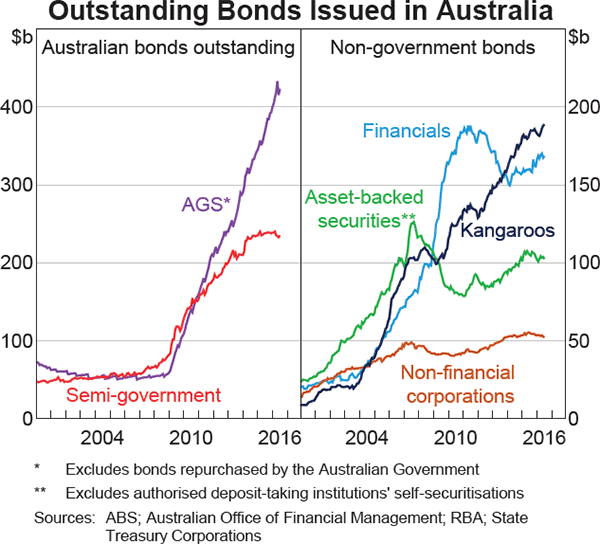
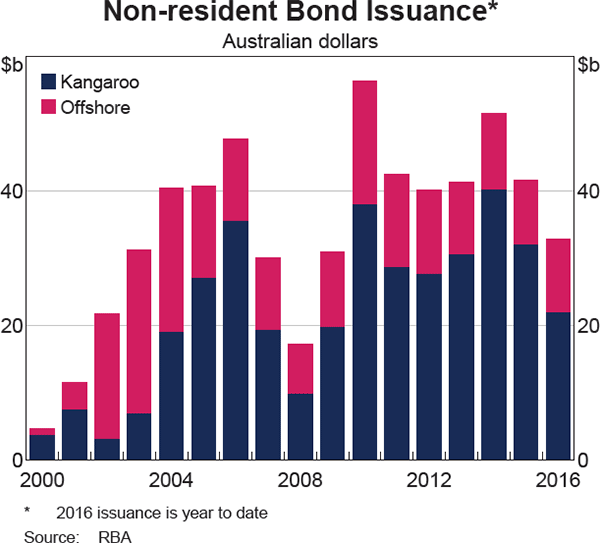
Non-resident issuance of Australian dollar-denominated bonds, particularly Kangaroo bonds, rose substantially during the early to mid 2000s. This was supported by a number of factors, including increased demand from foreign investors for higher-yielding Australian dollar assets and the development of the Australian dollar swap market, which enabled foreign investors and issuers to hedge their foreign exchange risk. Both Kangaroo bond issuance and non-resident offshore issuance of Australian dollar-denominated bonds dipped around the time of the financial crisis, but subsequently recovered and have since been fairly stable. The value of bonds outstanding has continued to increase.
The Attraction of Non-resident Issuance in Australian Dollars
Kangaroo issuers access the Australian bond market in order to diversify their funding sources. The decision by non-residents to issue in Australian dollars is driven by factors such as the relative cost of issuance (including hedging costs) and the liquidity of underlying derivative and bond markets. A key characteristic of the Australian swap market is the persistent positive ‘basis’ that issuers receive as a premium for their Australian dollars in exchange for foreign currencies, such as the US dollar, in the cross-currency swap market (Graph 3). For example, through a cross-currency basis swap, the issuer can lend Australian dollars at the bank bill swap rate (BBSW) plus the basis, while paying the US dollar London inter-bank offered rate (LIBOR) for the US dollars.[2]
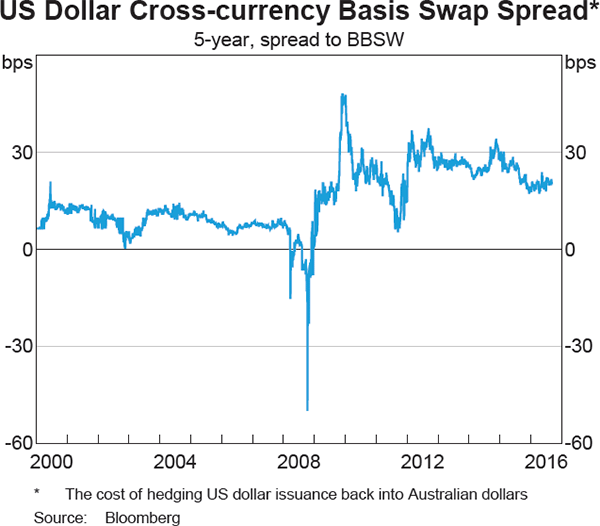
The basis is generally positive because the demand to swap foreign currency for Australian dollars exceeds the supply of those wanting to swap Australian dollars for foreign currency. This imbalance partly reflects the fact that Australian corporations, in particular Australian financial institutions, conduct the majority of their issuance offshore in foreign currency and, as noted above, swap this back into Australian dollars to hedge against the foreign exchange risk.[3] Offshore issuance allows Australian issuers access to a greater range of investors and deeper capital markets that are able to better meet their funding requirements. Through the use of intermediaries (such as global banks), non-resident issuers operate as important, indirect counterparties for Australian issuers interested in hedging their foreign currency exposures. Australian dollar issuance by non-residents is equivalent to around 40 per cent of foreign currency-denominated bonds issued by Australian entities (Graph 4).
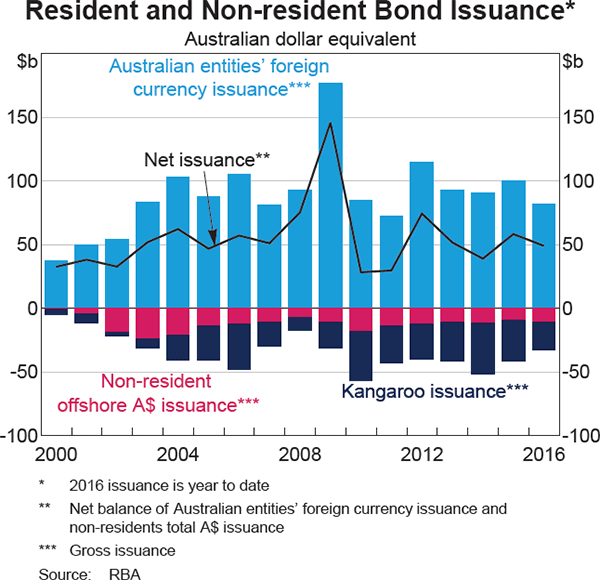
At the same time, there has been substantial global demand for Australian dollar-denominated assets. This reflects the combination of relatively high credit ratings (many non-resident issuers of Australian dollar bonds are AAA rated) and relatively high yields. In particular, these assets have considerable appeal to investors with mandates to only invest in highly rated securities, such as some reserve managers. Foreign interest in Australian dollar-denominated debt is also evident in the increase in foreign investment in AGS over the past 15 years (Graph 5).
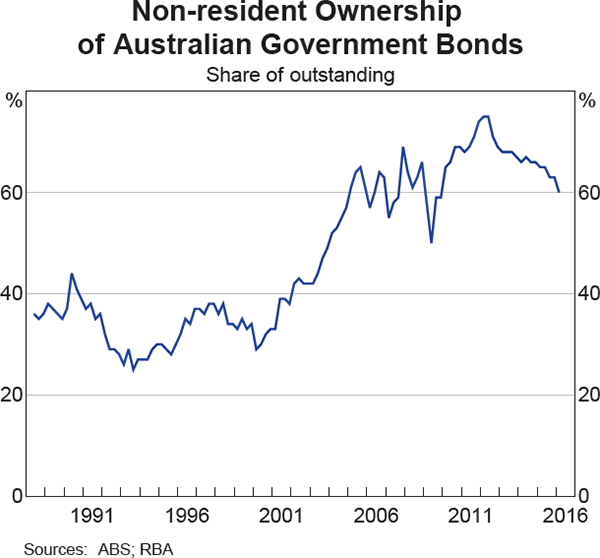
Types of Non-resident Issuers
The majority of non-resident Australian dollar issuers are supranational, sovereign or quasi-sovereign agency entities (collectively known as SSAs) (Graph 6). Non-SSA issuers largely comprise financial firms, although activity by non-financial corporate issuers has increased in recent years supported by US companies such as Apple and Coca-Cola.
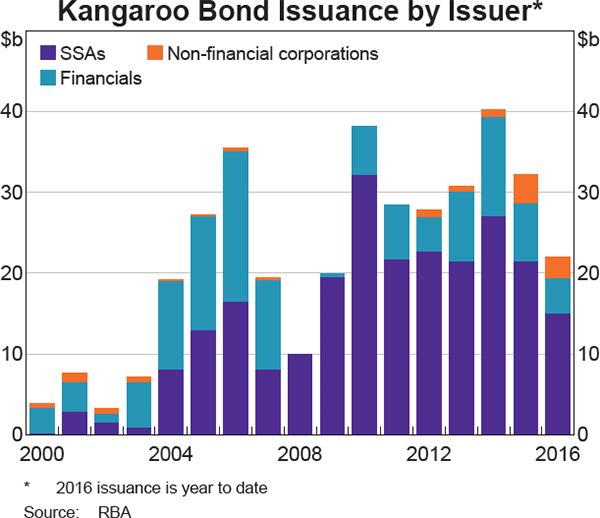
Issuance by SSAs
SSAs cover a broad range of issuers, which have different levels of government support. Supranational entities have multinational ownership structures, with institutions such as the World Bank (through the International Bank for Reconstruction and Development and the International Finance Corporation) and European Investment Bank accounting for a large share of SSA Kangaroo issuance. Quasi-sovereign agency issuers are standalone entities that often benefit from government support (either directly or indirectly) and are generally established to support a certain part of the economy, such as export financing and housing development. These agencies, particularly European agencies such as the German based KfW and Rentenbank, account for a large proportion of Kangaroo issuance. There is limited issuance by foreign sovereign issuers in Australia.
Sizeable Kangaroo bond issuance by SSAs began in 2004 as European supranationals and agencies shifted their Australian dollar issuance away from offshore markets (Graph 7). Kangaroo bond issuance declined substantially during the global financial crisis, amid heightened volatility in bond markets and a spike in issuance costs. Higher costs reflected a widening in Kangaroo bond spreads relative to benchmark interest rates and higher foreign currency hedging costs (Graph 8). Nevertheless, AAA rated supranationals continued to issue Kangaroo bonds during this period. Following the financial crisis, SSA issuance picked up sharply, peaking in 2010, and has been broadly stable in recent years.
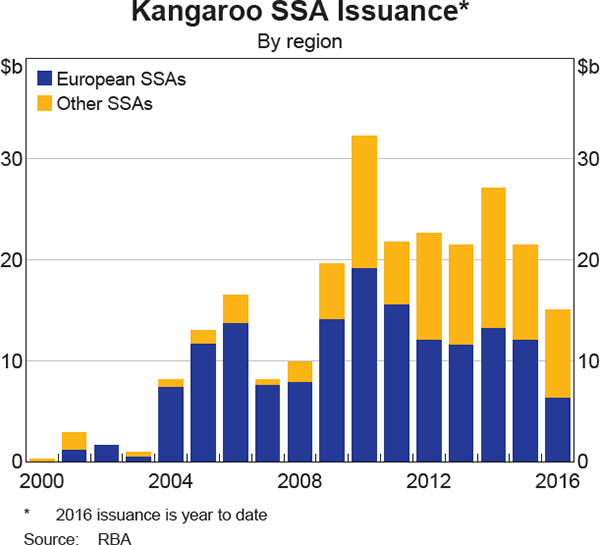
The global funding programs of many SSAs have declined over the past five years and a larger proportion of their funding has been sourced in US dollars, reflecting more favourable US dollar funding conditions of late due to movements in the cross-currency swap market. Despite this, the share of SSAs' funding in Australian dollars has been largely unchanged over the past few years. Large issuers typically aim to issue into the Kangaroo market regularly, even when issuance in other markets is more cost effective, as they prefer to maintain access to a broad range of capital markets and investors prefer issuers that regularly issue bonds.
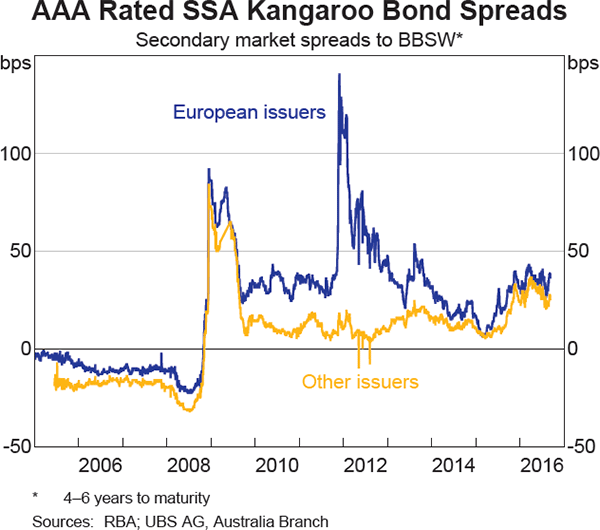
SSA issuance has been dominated by AAA rated entities. This may partly reflect investors' preferences, with AAA rated issuance attracting substantial demand from reserve managers and other institutional investors (as discussed above). While issuance by non-AAA rated SSAs has picked up since 2011, this has been concentrated among a few issuers, mostly Canadian provinces. In contrast, a number of SSAs ceased issuing Kangaroo bonds after losing their AAA credit ratings following the global financial crisis and amid concerns around European sovereign debt.
Around half the bonds issued by SSAs have maturities of around five years, with reserve managers reported to be significant buyers up to this tenor (Graph 9). An increasing share of issuance has had a tenor of around 10 years, which has been supported by a shift among SSA issuers to conduct frequent small ‘taps’ of existing longer-dated bonds. Some lengthening in the maturity of issuance is consistent with a general shift among issuers to increase the term of their fixed-rate debt given historically low interest rates. According to market participants, a lengthening in the tenor of SSA bonds has also been a response to increased investor interest from Japanese pension fund and life insurance companies, which prefer longer-dated investments to match the long duration of their liabilities (Collins 2014; Davison 2016).
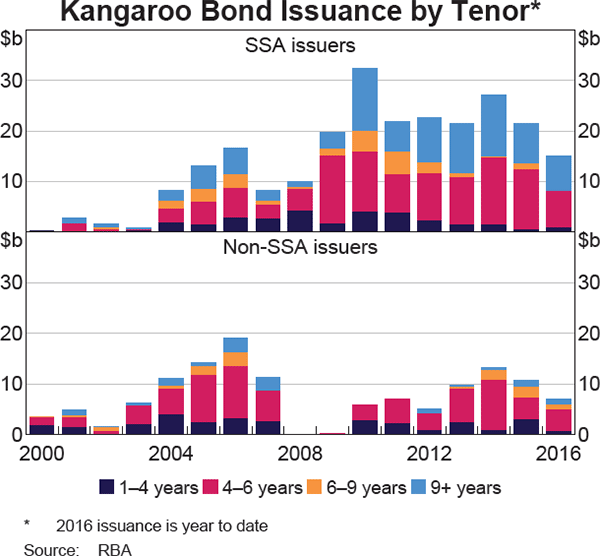
Issuance by financial corporations
The next largest Kangaroo bond issuers by volume have been financial corporations, with sizeable issuance from both European and US-domiciled banks. Issuance patterns have been notably cyclical, with a complete absence of the banks from the market during the financial crisis (Graph 10). Issuance by banks resumed in 2010, albeit with consistently lower volumes by both European and US banks compared with the pre-crisis peak. However, this reduction has been partly offset by issuance from Canadian banks, which have tended to issue AAA rated covered bonds. Asian banks have never had a significant presence in the Kangaroo market, as many Asian banks with higher credit ratings have limited borrowing needs due to strong deposit bases or have issued bonds through their Australian branches or subsidiaries that have a requirement for Australian dollar funding.
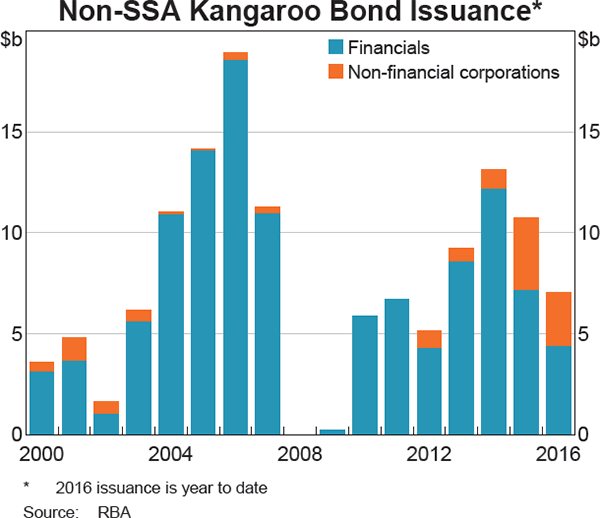
Issuance by non-financial corporations
Following an extended absence precipitated by the global financial crisis, non-financial corporate Kangaroo issuance resumed in 2012 (Graph 10). Initial activity was supported by issuance from a handful of larger British and US companies as well as Korean entities (often with strong government links). Non-financial corporations have comprised a greater share of non-SSA Kangaroo issuance since 2012 compared with the pre-crisis period, accounting for close to 20 per cent of recent non-SSA issuance. According to market participants, the increase in non-financial corporate issuance has been supported by increased investor appetite for non-AAA rated issuance alongside the global ‘search for yield’ trend driven by low government bond yields.
Issuance by non-financial corporations increased substantially in 2015 and 2016. Much of the increase was driven by a small number of very large deals by US corporations. In particular, Apple completed the largest ever Kangaroo deal in August 2015, raising $2.25 billion, followed by a further $1.45 billion in June 2016.[4]
In contrast to SSA issuance, corporate Kangaroo deals have tended to be larger and have often involved multi-tranche deals across different tenors. These deals have generally entailed a combination of bonds with a shorter tenor (often four years) and longer tenor bonds (generally seven to 10 years). This strategy enables corporations to issue bonds with a wide range of maturities to attract different investors. Recent deals have generated substantial demand from domestic participants at shorter tenors, while longer tenors have been dominated by offshore investors.
Conclusion
Kangaroo bonds are an important source of highly rated securities in the Australian bond market, with issuers also acting as important indirect counterparties for Australian firms in the cross-currency swap market. Kangaroo bond issuance has increased significantly since the early 2000s and has recovered strongly after a dip in issuance during the global financial crisis. Since the financial crisis, issuance has primarily been from AAA rated SSAs, but over the past few years there has been increased issuance from a broader range of entities, particularly non-financial corporations.
Footnotes
The authors are from Domestic Markets Department. [*]
The difference between domestic and offshore Australian dollar issuance depends on where the securities are deposited. For example, domestic issuance is typically issued and deposited in the Austraclear central securities depository (CSD) while offshore issuance is deposited in international CSDs such as Euroclear and Clearstream. [1]
A cross-currency basis swap is a derivative instrument that involves an exchange of principal in different currencies, as well as the payment of interest in one currency and the receipt of interest in a different currency at a predetermined fixed exchange rate. They are often used to hedge the foreign exchange risk associated with longer-term debt securities. For further details, see Arsov et al (2013). [2]
Some Australian entities (in particular the major mining companies that have US dollar earnings) do not hedge back their offshore issuance as they have foreign income and assets that are more appropriately matched by foreign currency debt liabilities. [3]
Apple has undertaken sizeable global corporate bond issuance in recent years despite having considerable cash holdings outside the United States. [4]
References
Arsov I, G Moran, B Shanahan and K Stacey (2013), ‘OTC Derivatives Reforms and the Australian Cross-Currency Swap Market’, RBA Bulletin, June Quarter, pp 55–63.
Collins N (2014), ‘Exploring Alternative Pockets of Liquidity: Non-Core Opportunities Abound Despite Swap Cost Woes’, in ‘Financing Sovereigns, Supranationals and Agencies’, GlobalCapital Special Report, March, pp 62–63.
Davison L (2016), ‘Sticky Wicket’, KangaNews, February-March, pp 48–53.